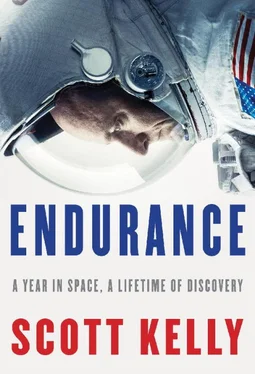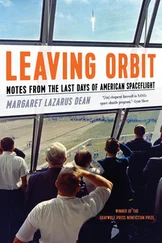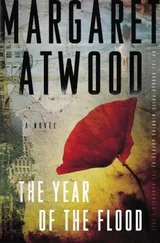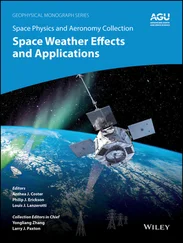I turn out the light and float for a while before falling asleep.
—
NEW YEAR’S Eve is a bigger holiday than Christmas on the space station because it’s celebrated by all nations on the same day. We gather in the Russian segment for the festivities. We all have something to eat, someone makes a toast. We continue that way on into the night. We briefly turn out the lights to see whether we can glimpse any fireworks on Earth—on my previous long-duration flight we were able to see the tiny specks of colored light, but this year we don’t see any. It is still a privilege to be spending my second New Year’s Eve in space, and I’m glad I’m still able to appreciate where I am and what I am getting to do. The next morning I get up early to call my friends and family in the United States to wish them a happy 2016—the year I will come home.
19

January 7, 2016
Dreamed Amiko and some of my astronaut colleagues arrived unexpectedly on the space station. They had come on a bus, which made sense in the dream. I went to the U.S. lab to clean up a bit and found a cigarette my dad had left smoldering. The cigarette started to catch on loose papers floating around. I shouted at everyone to evacuate, and I stayed behind to fight the fire with a garden hose, which I was surprised to find coiled on the wall along with all of the other equipment we keep in there. It didn’t work very well, though, because the space station was made of dried wood. The fire grew until there were flames all around me, and I fought it until I woke up.
TOMORROW IS the fifth anniversary of the shooting in Tucson that injured Gabby. The approach of this day has made me think about what I was doing when Gabby was shot. I was fixing the toilet, and now the same toilet is failing in the exact same way.
As weird as this is, we’ve sort of known this day was coming. We were hundreds of days beyond what was supposed to be the lifespan of the toilet’s pump separator, and I had started to see it as a challenge to keep it limping along past the point when the ground had suggested I should replace it. I should have listened to them, because if it fails catastrophically it produces an enormous sphere of urine mixed with the sulfuric acid pretreat, a gallon of nastiness I would have to clean up.
Five years ago, I was orbiting 250 miles above my family when they needed me most. So much has changed since then; yet I’m in the same place, doing the same thing, as we honor the victims of the shooting with a moment of silence.
—
TODAY, January 15, 2016, is a great day on the International Space Station because a spacewalk is going on and I’m not doing it. I will always be glad that I had the chance to experience the thrill of floating outside the station with nothing but a spacesuit between me and the cosmos, but at least for now, I am more than fine with sitting this one out. It’s also a thrill to see Tim Peake become the first official British astronaut to do a spacewalk.
Today I am serving as IV. I make sure both Tims get into their suits properly, call out the steps as they check over their tools and check their spacesuits’ functions, and operate the airlock. Tim and Tim are replacing the power regulator that failed back in September while Amiko was on console in mission control, as well as installing some new cabling. They get through those tasks and a few others successfully before Tim Kopra’s CO 2sensor malfunctions. This isn’t a big deal in itself, because he can self-monitor his CO 2levels based on his symptoms, but soon after, he reports a water bubble inside his helmet. If the bubble were small, we might have speculated that it was a drop of sweat that had broken free, but the bubble is big. Tim also reports that when he pushes his head back against the absorbent pad in his helmet, there is a squishing noise, a sign that more water than just that bubble is in his helmet.
Tim and Tim have been outside for only four hours, and they have a number of items left on their to-do list, but a water leak in a helmet always means it’s time to come back inside, now. Tim Peake will clean up the work sites as Tim Kopra heads immediately back to the airlock. We want to get them back inside quickly, but rushing increases the chances of something going wrong. So we go through the procedures methodically, one by one, so as to be sure we aren’t screwing anything up. I think of a saying I once heard that was attributed to the Navy SEALs: “Slow is efficient. Efficient is fast. Slow is fast.” When I bring them back inside, I get Kopra’s helmet off first. He seems fine, if a bit moist. Then we get Peake’s helmet off. They both look tired, but neither of them have the exhausted look that Kjell and I had after our first two spacewalks. We’d been in our suits almost twice as long.
A few days later, the Seedra in Node 3 fails again. Often when it goes down, the ground can get it up and running again, and I spend the day hoping they will be successful. I’ve been daring to hope that I could get back to Earth without having to mess with the Seedra again, so when the ground tells us that Tim Kopra and I will have to take it apart and spend a couple of days on repairs to get it working, I acknowledge it with a heavy heart.
The next day, Tim and I slide the beast out of its rack, move it to Node 2, secure it to a workbench, and take it apart. Over the course of the day, we isolate the problem. When I took this machine apart with Terry Virts, it was a multiday operation that left him bandaged and both of us tired and frustrated. Today, I’m aware from the start that the repair is going much better than it had previously. It’s still a very complicated and challenging job—just moving the five-hundred-pound mass is a hassle when it could damage a hatch seal, sensitive equipment, or a body part. But I’ve had so much experience with this machine that I can now work on it with an incredible level of confidence and efficiency. At this point, I could write a repair manual for this damn thing if I wanted to. I feel like I know it the way a cardiologist knows a human heart.
We save time by using tricks I’ve figured out on previous repairs and get the work done in a fraction of the time it took Terry and me to do it back in April. I can’t help but take some pride in that. I also can’t help but wish fervently that I will never have to take this thing apart again.
Later in the day, I’m working in the Japanese module when I come across a drink bag wedged behind a piece of equipment. I dislodge it and find it’s marked with the initials DP. No one up here has the initials DP, or has in a long time. It must have belonged to Don Pettit, who was last here in 2012. I save the bag until Don is working as capcom, then hold it up in front of the camera and ask, “Is this your drink bag?”
Don laughs at the absurdity of the situation. But he understands, as all space station astronauts do, how easily objects get lost up here. At home you would never put down a glass of water and lose it for three years, but up here, as careful as we are, it’s incredibly easy to lose your drink or anything else. There is just too much stuff, and it all floats.
A few days later, I take a great picture of the city of Houston and the Gulf Coast on a beautiful night pass. When I send it to Amiko, I use the word “home,” and I’m surprised to find that I’m starting to set my internal compass there again. I’m starting to allow myself to look forward to getting back. I hadn’t been able to indulge in these kinds of thoughts for most of the year, but now it actually feels good to yearn for home a bit, knowing I’ll be there soon.
Читать дальше













